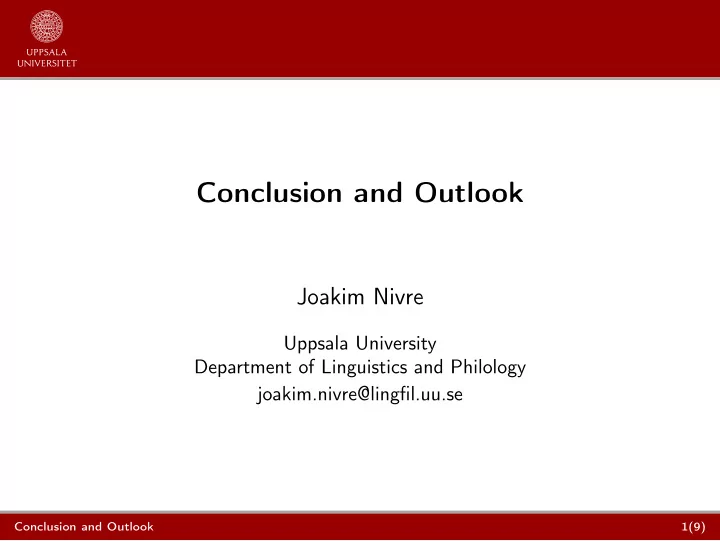

Conclusion and Outlook Joakim Nivre Uppsala University Department of Linguistics and Philology joakim.nivre@lingfil.uu.se Conclusion and Outlook 1(9)
1. Synthesis 2. Ensemble Systems 3. Domain Adaptation 4. Cross-Language Variation 5. Unsupervised Parsing Conclusion and Outlook 2(9)
Synthesis ◮ Feature-rich discriminative factored models ◮ Global learning (conditional or discriminative) ◮ Dynamic programming or beam search decoding Conclusion and Outlook 3(9)
Ensemble Systems ◮ Parser outputs (for sentence x ): y 1 , . . . , y m ◮ Arc scores: Score ( i , l , j , x ) = |{ y k : ( i , l , j , x ) ∈ y k }| ◮ Maximum spanning tree parsing Conclusion and Outlook 4(9)
Domain Adaptation WSJ Brown Genia SWBD 89.7 84.1 76.2 76.7 Conclusion and Outlook 5(9)
Cross-Language Variation Arabic Basque Catalan Chinese Czech 76.5 76.9 88.7 84.7 80.2 English Greek Hungarian Italian Turkish 89.6 76.3 80.3 84.4 79.8 Conclusion and Outlook 6(9)
Cross-Language Variation Universal Dependencies ( http://universaldependencies.github.io/docs/) ◮ Google universal part-of-speech tags ◮ Interset morphological features ◮ Stanford universal dependencies ◮ Guidelines, version 1, October 2014 ◮ First set of treebanks (10 languages), January 2015 Conclusion and Outlook 7(9)
Unsupervised Parsing � P ( x | y ) = P ( x i , . . . , x j | y ij ) P ( x i − 1 , x j + 1 | y ij ) 1 ≤ i < j ≤ n Conclusion and Outlook 8(9)
Unsupervised Parsing � � P ! (! | h , d , ?) P ( T ( h )) = P ! ( ¬ ! | h , d , ?) P v ( a | h , d ) P ( T ( a )) d ∈ l , r a ∈ D ( h , d ) Conclusion and Outlook 9(9)
Recommend
More recommend